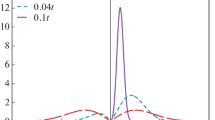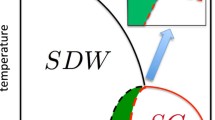Abstract
A framework for analytical studies of superconducting systems is presented and illustrated. The formalism, based on the conformal transformation of momentum space, allows one to study the effects of both the dispersion relation and the structure of the pairing interaction in two-dimensional anisotropic high-T c superconductors. In this method, the number of employed degrees of freedom coincides with the dimension of the momentum space, which is different compared to that in the standard Van Hove scenario with a single degree of freedom. A new function, the kernel of the density of states, is defined and its relation to the standard density of states is explained. The versatility of the method is illustrated by analyzing coexistence and competition between spin-singlet and spin-triplet order parameters in superconducting systems with a tight-binding-type dispersion relation and an anisotropic pairing potential. Phase diagrams of stable superconducting states in the coordinates η (the ratio of hopping parameters) and n (the carrier concentration) are presented and discussed. Moreover, the role of attractive and repulsive on-site interactions for the stability of the s-wave order parameter is explained.
Similar content being viewed by others
References
P. Monthoux and G. G. Lonzarich, p-wave and d-wave superconductivity in quasi-two-dimensional metals, Phys. Rev. B 59(22), 14598 (1999)
P. Monthoux and G. G. Lonzarich, Magnetically mediated superconductivity in quasi-two and three dimensions, Phys. Rev. B 63(5), 054529 (2001)
P. Monthoux and G. G. Lonzarich, Magnetically mediated superconductivity: Crossover from cubic to tetragonal lat-tice, Phys. Rev. B 66(22), 224504 (2002)
A. Nazarenko and E. Dagotto, Possible phononic mecha-nism for d x2y2 superconductivity in the presence of short-range antiferromagnetic correlations, Phys. Rev. B 53(6), R2987 (1996)
D. Y. Xing, M. Liu, Y. G. Wang, and J. Dong, Analytic ap-proach to the antiferromagnetic van Hove singularity model for high-T c superconductors, Phys. Rev. B 60(13), 9775 (1999)
M. R. Norman and C. Pépin, The electronic nature of high temperature cuprate superconductors, Rep. Prog. Phys. 66(10), 1547 (2003)
R. Gonczarek, M. G ladysiewicz-Kudrawiec, The Van Hove Scenario in high-Tc superconductivity, Wroclow University of Technology Press, Wroclaw, 2004 (in Polish)
R. Gonczarek and M. Krzyzosiak, Conformal transforma-tion method and symmetry aspects of the group C 4v in a model of high-T c superconductors with anisotropic gap, Physica C 426(431), 278 (2005)
R. Gonczarek, L. Jacak, M. Krzyzosiak, and A. Gonczarek, Competition mechanism between singlet and triplet super-conductivity in the tight-binding model with anisotropic attractive potential, Eur. Phys. J. B 49(2), 171 (2006)
R. Gonczarek, M. Krzyzosiak, L. Jacak, and A. Gonczarek, Coexistence of spin-singlet s-and d-wave and spin-triplet p-wave order parameters in anisotropic superconductors, phys. stat. sol. (b) 244, 3559 (2007)
R. Gonczarek, M. Krzyzosiak, and A. Gonczarek, Is-lands of stability of the d-wave order parameter in s-wave anisotropic superconductors, Eur. Phys. J. B 61(3), 299 (2008)
M. Krzyzosiak, R. Gonczarek, A. Gonczarek, and L. Ja-cak, Interplay between spin-singlet and spin-triplet order parameters in a model of an anisotropic superconductor with cuprate planes, J. Phys. Conf. Ser. 152, 012057 (2009)
R. Szczȩsniak and A. P. Durajski, The characterization of high-pressure superconducting state in Si2H6 compound: The strong-coupling description, J. Phys. Chem. Solids 74(4), 641 (2013)
R. Szczȩsniak, SDW antiferromagnetic phase in the two-dimensional Hubbard model: Eliashberg approach, Phys. Lett. A 373(4), 473 (2009)
W. Kohn and J. M. Luttinger, New mechanism for super-conductivity, Phys. Rev. Lett. 15(12), 524 (1965)
Y. A. Krotov, D. H. Lee, and A. V. Balatsky, Superconduc-tivity of a metallic stripe embedded in an antiferromagnet, Phys. Rev. B 56(13), 8367 (1999)
M. Granath and H. Johannesson, One-dimensional electron liquid in an antiferromagnetic environment: Spin gap from magnetic correlations, Phys. Rev. Lett. 83(1), 199 (1999)
A. P. Durajski and R. Szczȩsniak, Characterization of phonon-mediated superconductivity in lithium doping borocarbide, Solid State Sci. 42, 20 (2015)
A. P. Durajski, Phonon-mediated superconductivity in compressed NbH4 compound, Eur. Phys. J. B 87(9), 210 (2014)
P. W. Anderson, The resonating valence bond state in La2CuO4 and superconductivity, Science 235(4793), 1196 (1987)
P. W. Anderson, The Theory of High-Tc Superconductivity in the Cuprates, Princeton University Press, 1997
L. D. Landau, The Theory of a Fermi Liquid, Zh. Eksp. Teor. Fiz. 80, 1058 (1956) [Sov. Phys. JETP 3, 920 (1956)]
L. D. Landau, Oscillations in a Fermi liquid, Zh. Eksp. Teor. Fiz. 32, 59 (1957) [Sov. Phys. JETP 5, 101(1957)]
M. Krzyzosiak, R. Gonczarek, A. Gonczarek, and L. Jacak, Conformal Transformation Method in Studies of High-Tc Superconductors — Beyond the Van Hove Scenario, in: Su-perconductivity and Superconducting Wires, edited by D. Matteri and L. Futino, Nova Science Publishers, 2010, Ch. 5
R. Gonczarek, M. Krzyzosiak, and M. Mulak, Valuation of characteristic ratios for high-T c superconductors with anisotropic gap in the conformal transformation method, J. Phys. A 37(18), 4899 (2004)
R. Gonczarek, M. Gladysiewicz, and M. Mulak, On pos-sible formalism of anisotropic Fermi liquid and BCS-type superconductivity, Int. J. Mod. Phys. B 15(05), 491 (2001)
F. C. Zhang and T. M. Rice, Effective Hamiltonian for the superconducting Cu oxides, Phys. Rev. B 37(7), 3759 (1988)
R. Micnas, J. Ranniger, and S. Robaszkiewicz, Supercon-ductivity in narrow-band systems with local nonretarded attractive interactions, Rev. Mod. Phys. 62(1), 113 (1990)
E. Pavarini, I. Dasgupta, T. Saha-Dasgupta, O. Jepsen, and O. K. Andersen, Band-structure trend in hole-doped cuprates and correlation with T rmcmax, Phys. Rev. Lett. 87(4), 047003 (2001)
O. K. Andersen, A. I. Liechtenstein, O. Jepsen, and F. Paulsen, LDA energy bands, low-energy hamiltonians, t', t'', t(k), and J, J. Phys. Chem. Solids 56(12), 1573 (1995)
O. K. Andersen, S. Y. Savrasov, O. Jepsen, and A. I. Liecht-enstein, Out-of-plane instability and electron-phonon con-tribution to s- and d-wave pairing in high-temperature su-perconductors; LDA linear-response calculation for doped CaCuO2 and a generic tight-binding model J. Low Temp. Phys. 105(3–4), 285 (1996)
R. Gonczarek, M. G. ladysiewicz, and M. Mulak, Equi-librium states and thermodynamical properties of d-wave paired HTSC in the tightbinding model, phys. stat. sol. (b) 233, 351 (2002)
M. M. Maska, M. Mierzejewski, B. Andrzejewski, M. L. Foo, R. J. Cava, and T. Klimczuk, Possible singlet-to-triplet pairing transition in NaxCoO2-y H2O, Phys. Rev. B 70, 144516 (2004)
J. Bouvier and J. Bok, The Gap Symmetry and Fluc-tuations in High T c Superconductors, Eds. J. Bok, G. Deutscher, D. Pavuna, and S. Wolf, New York: Plenum Press, 1998, p. 37
R. S. Markiewicz, A survey of the Van Hove scenario for high-T c superconductivity with special emphasis on pseudo-gaps and striped phases, J. Phys. Chem. Solids 58(8), 1179 (1997)
H. Q. Lin and J. E. Hirsch, Two-dimensional Hubbard model with nearest-and next-nearest-neighbor hopping, Phys. Rev. B 35(7), 3359 (1987)
M. Sigist and K. Ueda, Phenomenological theory of uncon-ventional superconductivity, Rev. Mod. Phys. 63(2), 239 (1991)
H. Ghosh, Higher anisotropic d-wave symmetry in cuprate superconductors, J. Phys.: Condens. Matter 11(30), L371 (1999)
Q. Yuan and P. Thalmeier, BCS theory for s + g-wave su-perconductivity in borocarbides Y(Lu)Ni2B2C, Phys. Rev. B 68(17), 174501 (2003)
H. Shimahara and S. Hata, Superconductivity in a ferro-magnetic layered compound, Phys. Rev. B 62(21), 14541 (2000)
J. González, Microscopic description of d-wave supercon-ductivity by Van Hove nesting in the Hubbard model, Phys. Rev. B 63(2), 024502 (2000)
E. Ya. Sherman, Raman vertex in cuprates: Role of the extended Van Hove singularity, Phys. Rev. B 58(21), 14187 (1998)
R. Gonczarek and M. Krzyzosiak, On possibility of realiza-tion of d- or p-wave symmetry states in anisotropic super-conductors, Acta Phys. Pol. A 109(4–5), 493 (2006)
R. Gonczarek and M. Krzyzosiak, On a model of supercon-ductivity realized in the metallic phase of strongly corre-lated electrons revealing a first-order phase transition, Int. J. Mod. Phys. B 17(30), 5683 (2003)
R. Gonczarek and M. Krzyzosiak, Critical parameters in the superconducting singular Fermi liquid model, Physica C 445–448, 158 (2006)
A. P. Durajski, The anisotropic evolution of the energy gap in Bi2212 superconductor, Front. Phys. 11, 117408 (2016)
C. C. Tsuei, D. M. Newns, C. C. Chi, and P. C. Pattnaik, Anomalous isotope effect and Van Hove singularity in su-perconducting Cu oxides, Phys. Rev. Lett. 65(21), 2724 (1990)
C. C. Tsuei, D. M. Newns, C. C. Chi, and P. C. Pattnaik, Tsuei et al. reply, Phys. Rev. Lett. 68(7), 1091 (1992)
E. Dagotto, A. Nazarenko, and M. Boninsegni, Flat quasi-particle dispersion in the 2D t–J model, Phys. Rev. Lett. 73(5), 728 (1994)
E. Dagotto, Correlated electrons in high-temperature su-perconductors, Rev. Mod. Phys. 66(3), 763 (1994)
E. Dagotto, A. Nazarenko, and A. Moreo, Antiferromag-netic and van Hove scenarios for the cuprates: Taking the best of both worlds, Phys. Rev. Lett. 74(2), 310 (1995)
J. M. Getino, M. de Llano, and H. Rubio, Properties of the gap energy in the van Hove scenario of high-temperature superconductivity, Phys. Rev. B 48(1), 597 (1993)
R. S. Markiewicz, Van Hove excitons and high-Tc super-conductivity (VI): Properties of the exitations, Physica C 168(1–2), 195 (1990)
R. S. Markiewicz, Van Hove excitons and high-Tc supercon-ductivity (VI): Gap equation with pair breaking, Physica C 183, 303 (1991)
R. S. Markiewicz, C. Kusko, and V. Kidambi, Pinned Balseiro-Falicov model of tunneling and photoemission in the cuprates, Phys. Rev. B 60(1), 627 (1999)
H. H. Fertwell, A. Kaminski, J. Mesot, J. C. Campuzano, M. R. Norman, M. Randeria, T. Sato, R. Gatt, T. Taka-hashi and K. Kadowaki, Fermi surface of Bi2Sr2CaCu2O8, Phys. Rev. Lett. 84(19), 4449 (2000)
S. V. Borisenko, M. S. Golden, S. Legner, T. Pichler, C. Dürr, M. Knupfer, J. Fink, G. Yang, S. Abell, and H. Berger, Joys and pitfalls of Fermi surface mapping in Bi2Sr2CaCu2O8+δ using angle resolved photoemission, Phys. Rev. Lett. 84(19), 4453 (2000)
K. Kuboki, Effect of band structure on the symmetry of su-perconducting states, J. Phys. Soc. Jpn. 70(9), 2698 (2001)
R. Gonczarek and M. Krzyzosiak, Some universal relations between the gap and thermodynamic functions plausible for various models of superconductors, phys. stat. sol. (b) 238, 29 (2003)
R. Gonczarek and M. Mulak, Enhancement of critical tem-perature of superconductors implied by the local fluctuation of EDOS, Phys. Lett. A 251(4), 262 (1999)
Author information
Authors and Affiliations
Corresponding authors
Rights and permissions
About this article
Cite this article
Krzyzosiak, M., Gonczarek, R., Gonczarek, A. et al. Applications of the conformal transformation method in studies of composed superconducting systems. Front. Phys. 11, 117407 (2016). https://doi.org/10.1007/s11467-016-0579-0
Received:
Accepted:
Published:
DOI: https://doi.org/10.1007/s11467-016-0579-0




